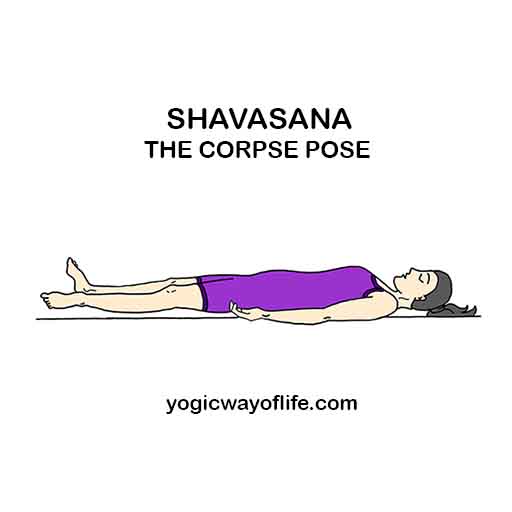Shavasana, the corpse pose is a yogic relaxation pose. The name comes from the sanskrit words Shava meaning “corpse” and Asana meaning “posture”. Shavasana is the simplest and the main relaxation pose used in yoga. It is usually performed at the beginning and at the end of yoga practices. It is also used as a resting pose between other yoga asanas.

In Shavasana, emphasis is given to slow, rhythmic and relaxed breathing. The yogic breath is a complete breath done with full awareness. The abdomen, the chest and the neck (clavicular region) expands during a relaxed deep breath. As one relaxes more, the abdominal breathing is more prominent. We may have the habit of breathing from the chest and neck region when we are tense. You may observe that when we are relaxed, the abdominal breathing takes over.
Observe the breathing of an infant lying on its back in the bed. How slowly and rhythmically he or she breathes and how smoothly the abdomen goes up and down. Observe the up and down motion of the abdomen. This relaxed breathing comes naturally to children when they are born. But as we grow up, we develop irregularities in the breathing process due to stress and strain of life.
Also women tend to use clavicular breathing (or breathing from the neck region) during pregnancy as it is difficult to do full abdominal breathing during that stage. That is normal. But what happens is that for many women this may become a habit, even after child delivery.
All these problems with irregular breathing can be corrected by practicing yogic breath. In the yogic breath, as one breathes in, one expands the abdomen first, then the chest and then the neck region. When breathing out, the process is reversed. The neck and chest region contracts first and finally the abdomen.
In Shavasana, the practitioner starts off with the complete yogic breath. But, after just few breaths, one feels relaxed. Then the breath will spontaneously become shallow. At that point, just the abdominal breathing takes over and should be followed during rest of the practice.
How to do Shavasana?
- Lie down on the floor on your back.
- Place your hands next to the body, slightly spread out with palms facing upwards.
- Spread your legs at a slight angle and feel as relaxed as possible.
- Consciously relax all the muscles in your body from head to toe.
- Let your breathing be slow and deep. Focus your attention on your belly and observe the slow and rhythmic abdominal breathing.
- You can maintain this position for as long as you need ranging from 5 – 30 minutes. Make sure you don’t sleep during the process.
To release this position, take a few deep breaths and slowly roll over to the side. Use your arms and raise yourself to the seated position.
Benefits of Shavasana
Shavasana releases stress from all muscles in the body. It relaxes the body and mind, giving a sense of well being. It can be done after a workout or after performing other asanas. Shavasana rejuvenates and rebuilds the body. Shavasana decreases the heart rate, the rate of respiration and the blood pressure. Shavasana reduces the metabolic rate, gives deep relaxation, reduces anxiety, alleviates mild depression and improves sleep.
